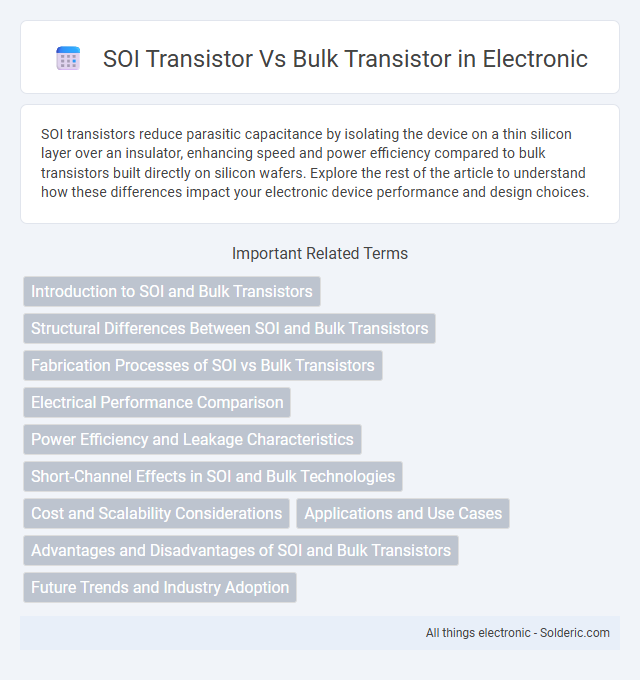SOI transistors reduce parasitic capacitance by isolating the device on a thin silicon layer over an insulator, enhancing speed and power efficiency compared to bulk transistors built directly on silicon wafers. Explore the rest of the article to understand how these differences impact your electronic device performance and design choices.
Comparison Table
| Feature | SOI Transistor | Bulk Transistor |
|---|---|---|
| Structure | Silicon layer on insulating substrate (Silicon-on-Insulator) | Silicon directly on silicon wafer (Bulk silicon) |
| Parasitic Capacitance | Lower due to insulation layer | Higher due to direct substrate contact |
| Leakage Current | Reduced leakage currents | Higher leakage currents |
| Power Consumption | Lower dynamic and static power | Higher power consumption |
| Speed | Higher speed due to reduced parasitics | Lower speed comparatively |
| Thermal Management | Poorer heat dissipation | Better heat dissipation |
| Cost | More expensive, complex fabrication | Cheaper, simpler manufacturing |
| Radiation Hardness | Better tolerance for radiation | Less radiation tolerant |
Introduction to SOI and Bulk Transistors
SOI (Silicon-On-Insulator) transistors feature a thin silicon layer separated from the substrate by an insulating layer, reducing parasitic capacitance and improving speed and power efficiency compared to Bulk transistors, which are fabricated directly on silicon substrate. Bulk transistors exhibit higher substrate coupling and leakage currents, affecting overall device performance and thermal management. Your choice between SOI and Bulk technology impacts device scaling, power consumption, and suitability for high-performance or low-power applications.
Structural Differences Between SOI and Bulk Transistors
SOI transistors feature an insulating layer of silicon dioxide beneath the silicon channel, which isolates the device from the bulk substrate, reducing parasitic capacitance and leakage currents compared to bulk transistors. In contrast, bulk transistors are fabricated directly on the silicon substrate, leading to higher junction capacitance and potential substrate noise interference. Understanding these structural differences can help optimize your circuit design for performance and power efficiency.
Fabrication Processes of SOI vs Bulk Transistors
SOI transistors are fabricated on a thin silicon layer separated from the bulk substrate by a buried oxide layer, reducing parasitic capacitance and improving performance. In contrast, bulk transistors are built directly on the silicon wafer, where channel doping and isolation are critical to control leakage and latch-up. The SOI process involves wafer bonding or SIMOX methods to create the insulating oxide layer, whereas bulk processes utilize traditional ion implantation and thermal oxidation techniques.
Electrical Performance Comparison
SOI transistors exhibit reduced parasitic capacitance and leakage current compared to bulk transistors, leading to higher switching speeds and improved power efficiency. The buried oxide layer in SOI devices effectively isolates the channel, enhancing short-channel effects control and allowing for better threshold voltage stability. Bulk transistors tend to have higher substrate coupling and leakage, which can degrade overall electrical performance in scaled technologies.
Power Efficiency and Leakage Characteristics
SOI transistors offer superior power efficiency by minimizing parasitic capacitance, which reduces dynamic power consumption compared to bulk transistors. Their inherent isolation structure significantly lowers leakage currents, enhancing overall device performance in low-power applications. You benefit from improved energy savings and thermal management when using SOI technology in your designs.
Short-Channel Effects in SOI and Bulk Technologies
SOI transistors exhibit significantly reduced short-channel effects compared to bulk transistors due to the insulation layer that minimizes parasitic capacitance and leakage currents. The buried oxide layer in SOI technology suppresses drain-induced barrier lowering (DIBL) and punch-through, enhancing device scalability and performance at nanometer scales. In contrast, bulk transistors suffer from increased short-channel effects caused by the direct silicon substrate, leading to higher off-state leakage and degraded threshold voltage control.
Cost and Scalability Considerations
SOI transistors incur higher manufacturing costs due to the complex process of creating the silicon-on-insulator wafer, which limits large-scale production compared to bulk transistors. Bulk transistors benefit from well-established, cost-efficient fabrication techniques and better scalability for high-volume applications. Despite higher initial expenses, SOI technology offers performance advantages that may justify costs in specialized, high-performance sectors.
Applications and Use Cases
SOI transistors are ideal for high-performance computing, RF applications, and low-power devices due to their reduced parasitic capacitance and improved speed. Bulk transistors dominate in cost-sensitive, high-volume manufacturing for consumer electronics and general-purpose integrated circuits. SOI technology is favored in aerospace and automotive sectors where radiation hardness and energy efficiency are critical.
Advantages and Disadvantages of SOI and Bulk Transistors
SOI transistors offer reduced parasitic capacitance and lower leakage currents compared to bulk transistors, resulting in improved speed and energy efficiency for high-performance applications. However, SOI devices can be more expensive to manufacture and may face challenges with self-heating due to the insulating layer. Bulk transistors benefit from lower production costs and mature fabrication techniques but suffer from higher leakage currents and limitations in scaling for ultra-low power designs, impacting overall performance in advanced nodes.
Future Trends and Industry Adoption
SOI transistors offer superior performance in power efficiency and thermal management, driving increased adoption in advanced semiconductor manufacturing for AI and 5G applications. Bulk transistors remain dominant in cost-sensitive markets due to mature fabrication processes but face scaling limitations as industry trends shift towards miniaturization and higher integration. Your choice between SOI and Bulk technologies will be influenced by the need for cutting-edge performance versus production cost-effectiveness in future semiconductor innovations.
SOI transistor vs Bulk transistor Infographic

 solderic.com
solderic.com